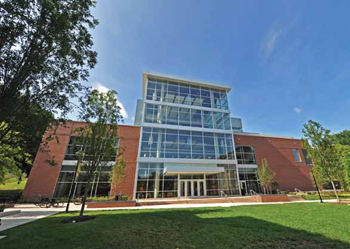Towson University’s New Ballroom Maximizes Control Over Disributed Audio
Towson University’s new West Village Commons building features a ballroom outfitted with a distributed audio system comprising 150 ISP Technologies HDDS CS 650p speakers under the control of three HDDS Master Control Modules.
Towson University, located eight miles north of Baltimore, MD, cut the ribbon in September on its brand new West Village precinct, a complex of student housing and other amenities. The new precinct includes a student services facility, West Village Commons, a $31.5 million, 85,000-square-foot, four-story, mixed-use building that includes a multipurpose ballroom with an ISP Technologies distributed audio system installed by Visual Sound of Arbutus, MD.
According to Andy Philip, senior systems engineer/programmer with Visual Sound, the decision to install ISP (Intelligent Signal Processing) Technologies equipment was very much driven by the client. “Frank Rankin, who is with Towson University, did the design and specification for the most part, and had his heart set on the ISP system,” he reported.
As it turns out, Rankin, production manager, event and conference services, technical operations for the university, has some history with ISP Technologies and a good working relationship with company co-founder James “Buck” Waller. “I’ve been a supporter of ISP for quite some time,” Rankin said, speaking during the final stages of the install. “I’ve had ISP systems for years here on campus. I also bought an ISP line array system for use in the stadium to pump up the volume a little bit.” Towson has even hosted demos, Rankin revealed, including one for the Naval Academy, who subsequently installed an ISP line array system.
The ballroom complex in the West Village Commons building can be divided into three identically sized spaces or a combination of those spaces. According to Philip, each room is approximately 80 feet by 40 feet, with 14-foot ceilings.
The distributed audio system includes 150 ISP Technologies HDDS CS 650p speakers under the control of three HDDS Master Control Modules. ISP’s High Definition Distributed System (HDDS) eschews more typical distributed audio topologies, such as 70V transformers and DSP control. Instead, the CS 650, a 6.5-inch ceiling speaker, features an internal 30-watt D-CAT (ISP Technologies’ patented Dynamic Current Amplifier Technology) power amplifier, and also offers equalization capabilities. The HDDS Master Control Module simply distributes low level AC current to power each ceiling speaker’s amplifier, along with the balanced audio signals, over Cat-5 cable. Level control of up to six zones is provided via voltage-controlled amplifiers.
“Every speaker is three-way powered; audio and power go up Cat-5,” noted Rankin. “Why hasn’t anybody thought of this before?”
There are 50 CS 650 speakers in each room. “I have my A, B, and C ballrooms,” Rankin explained. “Each ballroom has its own six-channel controller and I have each room divided into six zones. So I can control the volume anywhere in the room.”
Philip added, “I put the first two rows on separate zones so that he can drop it down by, say, nine dB on the first row and maybe six dB on the second row. The next eight rows are on the last four zones, two rows of speakers per zone.”
He continued, “There are two air-walls that can break it up into three rooms. Frank’s got four presets he can choose from. Preset one is the three separate rooms; preset two is A and B combined, with C separate; the third is B and C, with A separate; and the last preset is all of them combined.”
TOA 9000M2 mixers are additionally available in the rooms. “There are three wired mic inputs and two Shure wireless mics for each room,” said Philip. The rooms also include Eiki EIPHDT30 single-chip DLP projectors.
As the completion date neared, Rankin enthused, “The control is going to be phenomenal.”
Steve Harvey (psnpost@nbmedia.com) has been west coast editor for Pro Sound News since 2000 and also contributes to TV Technology and Pro Audio Review. He has 30 years of hands-on experience with a wide range of audio production technologies.
